How To Wear Sling Bags
Best Sling Bag
The minimalist’s guide to selecting a sling bag for travel, everyday carry, and beyond.
- 01. Introduction
- 02. Form
- 03. Function
- 04. Aesthetic
- 05. Conclusion
Updated: April 17, 2023
01 Introduction
Ready to embrace the sling bag trend? Step one: read this guide.
Travel Smarter with NordVPN
Get 4 months extra on a 2-year plan. It’s risk-free with Nord’s 30-day money-back guarantee! Check it out →
How to Choose the Best Sling Bag for Travel and Beyond
The ’90s are back and with them, the slightly edgier, far more hipster cousin of fanny packs—sling bags (and scrunchies, but that’s a guide for another time). Sling bags are, yes, a fashion statement, but also a convenient way to carry the essentials while traveling the world. Think of them as the middle ground between a backpack and your pockets.
In this guide, we’re going to walk you through how to choose the best sling bag for your situation, which means diving into all of the different aspects and explaining what works best for a variety of situations. We’re also going to provide some specific sling bag recommendations based on months of testing.
This guide is written and informed by the Pack Hacker team, all of whom are gear fiends, and some of whom have been wearing sling bags since before they were cool (#hipster). Testing and reviewing gear is our bread and butter here at Pack Hacker—our team of world travelers and digital nomads have tested and reviewed hundreds of different types of travel-specific gear at this point. In fact, we have used nearly all of the sling bags mentioned in this guide (and we’ll be getting our hands on those we haven’t very soon).
By the time you finish reading this guide, you’ll be a sling expert with all the knowledge necessary to find the best sling bag for you—or your mom, your friend, your dog, etc.
The Short Answer: The 10 Best Sling Bags for Travel, EDC, and Beyond
- CODEOFBELL X-POD
- Herschel Supply Co. Form Crossbody Large
- Chrome Industries Kadet
- WANDRD ROAM Sling
- Aer City Sling 2
- Osprey Daylite Sling (Shoulder Sling)
- Tom Bihn Side Effect
- KAVU Rope Sling
- Heimplanet Transit Line Sling Pocket
- lululemon Everywhere Belt Bag
- Fjallraven Greenland Pocket
- Trakke Banana Crossbody Bag
- Patagonia Atom Sling
- Minaal Crossbody Bag
- Pacsafe Venturesafe X Anti-Theft Sling Pack
- ALPAKA Go Sling Pro
- Peak Design Everyday Sling 6L (V2)
- Incase DSLR Sling Pack
Remember, there’s no one sling bag to rule them all, there’s just the best sling bag for you. So we highly suggest reading our complete guide to figure out your best fit (your future favorite one might not have made this list).
Video Overview: 10 Sling Bags For Every Occasion | Should You Travel With One?
Feel free to watch this guide overview in video format. We’ll go more in-depth in the written content and keep this page up to date.
What is a Sling Bag?
This question is not as straightforward as it seems. It’s taken a team of six bona fide gear reviewers analyzing 50+ sling bags and hip packs for over two months to come up with an answer we can all get behind (and there’s still some ambiguity).
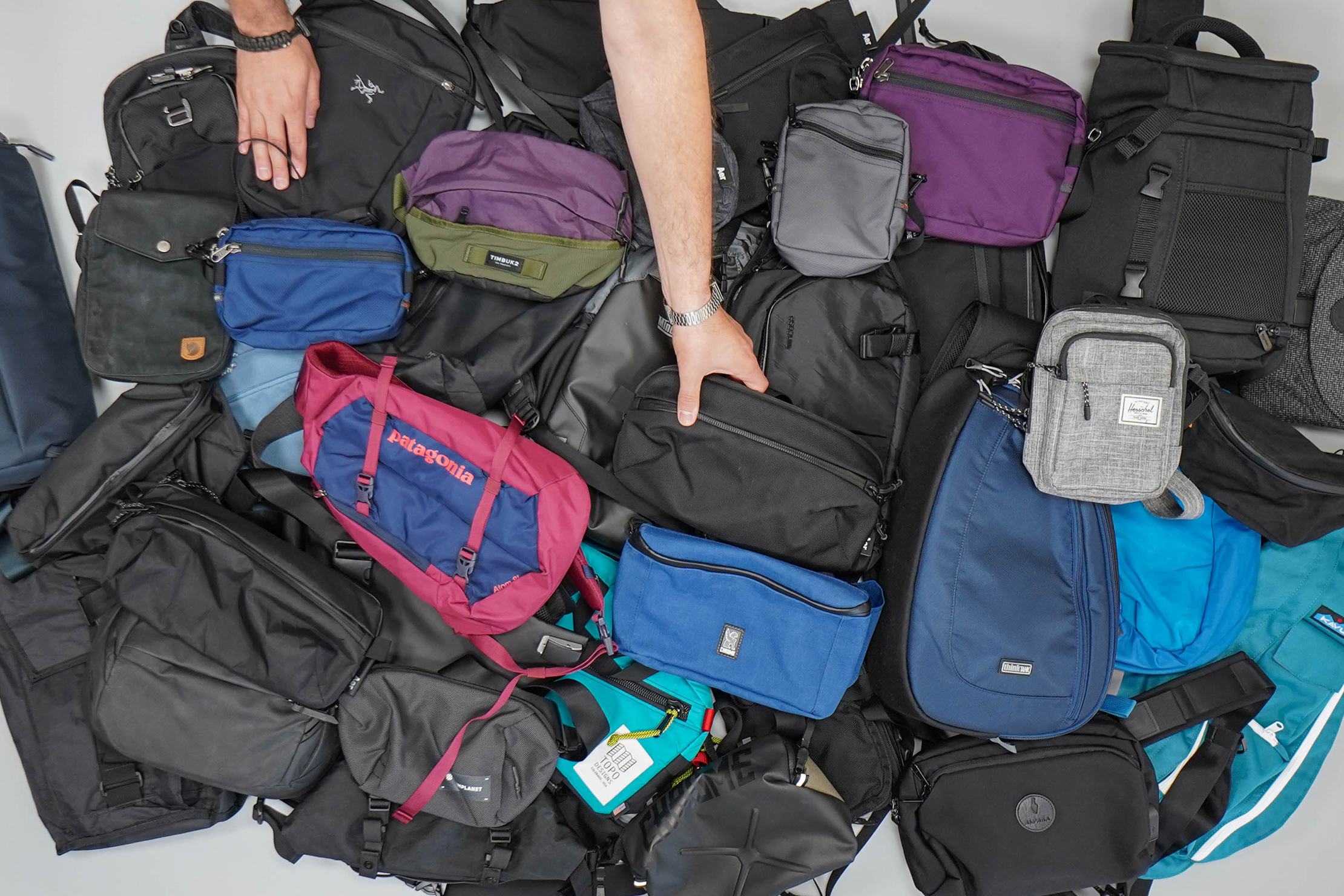
Here’s the definition we’ve landed on: A sling bag is (drum roll, please…) a bag that’s designed to be worn comfortably across the chest or back and secured to the body with a cross-shoulder style strap. The buckle tends to be off-center, the straps connect diagonally, and the body of the bag tends to have an oblong shape—we say “tends to” because there are quite a few exceptions, which we’ll get into later.
One small clarification is that while sling bags and messenger bags have a similar thing going on with the single, crossbody style of strap—the two aren’t synonymous. Messenger bags are usually bigger, boxier, and don’t contour to the body, but there’s no exact science. Really, you can go with your gut here. We tend to think you’ll know a messenger bag when you see one.
There is a massive variety of sling bag styles out there, including tactical slings (for outdoor sportsman stuff), high-fashion slings (think Gucci), and backpack slings (spacious enough for a laptop). While we’ll touch on those, we’re mainly going to focus on sling bags for travel in this guide.
What’s the Difference Between a Sling Bag and a Hip Pack?
You’ll see people on the internet equating sling bags with hip packs (or waist packs, fanny packs, bum bags, belt bags, whatever you want to call them), but sling bags and hip packs aren’t one and the same. We repeat: sling bags and hip packs are not the same things.
Simply put, a hip pack is the rebranded fanny pack, while a sling bag is something different (it’s the hipster cousin, remember?). A hip pack can almost always be a sling bag, albeit not necessarily a good one, but a sling bag is virtually never a hip pack (like a square is a rectangle, but a rectangle is not a square).
That said, almost every single company out there has its own definition of a sling bag and a hip pack. To make things even more complicated, some companies will throw in the term “crossbody bag” to describe what we consider a sling bag. So, it gets messy—and our rules and definitions are by no means absolutes.
In this guide, we won’t be discussing hip packs. Getting into the nitty-gritty of sling bags is complicated enough.
Editor’s Note: To all you fanny pack, excuse us, hip pack enthusiasts out there—we may work on a hip pack guide soon.
Why a Sling Bag?
Now that you know what a sling bag is, let’s talk about why one will change your life (or, at the very least, make carrying stuff easier).
Sling Bags Are Perfect for Your In-Flight Essentials
Since wearing one backpack on the front and one on the back hasn’t caught on yet (yes, we’re surprised too), a sling bag becomes a great place to keep your pocketable items, especially while in transit. Just toss all of your stuff in your sling and throw the entire thing in a bin as you breeze through airport security like a pro, thus avoiding the much-dreaded “security shuffle.”
And, unlike pockets, a sling bag will fit almost everything you could ever want in-flight (within reason—a masseuse obviously won’t fit). Of course, what you carry in your sling bag is as unique as you are. Here are a few suggestions based on what works for us:
- A smartphone
- Snacks (arguably the most important)
- USB cables
- Tech chargers
- Battery bank
- Earplugs (every plane has at least one crying baby, even if it’s your own; it’s like a law of physics or something)
- Eye mask
- Headphones
- Notebook and pen (something about being at 35,000 feet gets the creative juices flowing)
- Tissues
- An e-reader or book (depending on your sling, some are too small to fit one)
Once in flight, you can use a carabiner to hook your sling bag to the seat in front of you. That way, you can quickly grab a snack before you get hangry, some tissues because the movie you picked happens to be a lot sadder than you thought it’d be, or a phone charger because Tetris drains battery life surprisingly quickly. You know, only the essentials.
Sling Bags Are Perfect for Your Day Trip Essentials
Similar to the above perk, a sling bag may just be the perfect accessory for a day trip. Sometimes all you need are the basics—wallet, keys, phone—and while pockets may get the job done, 1) some clothes lack practical pockets, 2) skinny jeans are a thing, and 3) some clothes don’t have pockets at all. (*cough* Women’s clothing! *cough*)
Even if you are #blessed with useable pockets, some day trips require a few “extra” items, although not quite enough to make lugging around an entire backpack worthwhile. A sling bag allows you to bring:
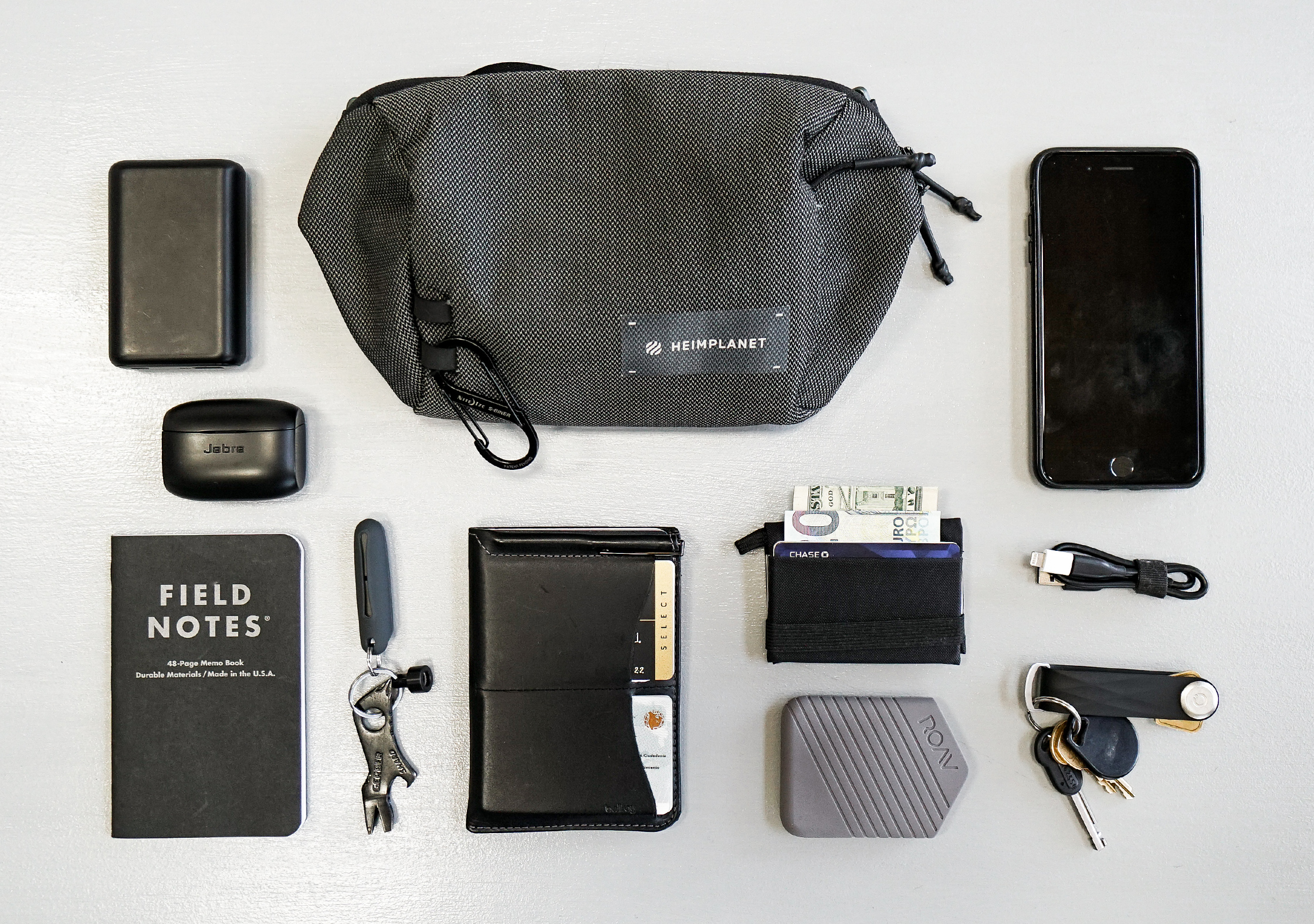
- Extra camera lenses
- Extra camera batteries
- Snacks (still the most important)
- Sunglasses
- Sunscreen
- Chapstick
- Makeup
- Nintendo Switch (a gamers gotta game)
Sling bags truly are the middle ground between a daypack and your pockets. If you’re usually a daypack kind of person, switching to a sling bag forces you to think about what you’re bringing. And your back will thank you for leaving that copy of War and Peace behind because, let’s be honest, you’re just going to look at memes on your smartphone anyway. Alternatively, if you’re usually a pocket kind of person, you can avoid overly-full pockets and think less about what you’re bringing, tossing all sorts of fun goodies into your sling bag just because you can.
Sling Bags Are Lightweight and Packable
Sling bags—specifically ones designed for travel—weigh almost nothing and can easily lay flat in your travel backpack. You can pack it and forget about it until you require your sling’s services (see the above perk).
Sling Bags Provide Easy Access
Sling bags are ridiculously easy to get in and out of. When worn on your chest, the pocket(s) is (are) literally right under your nose, and when worn on your back, you can shift it around to your front. However, beware of the T-Rex arms that can happen when the sling bag is worn high on your chest (yeah, you knew exactly what we were talking about as soon as we said “T-Rex arms,” didn’t you?).
Sling Bags Are En Vogue
At least for the time being, sling bags are “in.” You’ll find them in pretty much every high street store and even luxury brands like Louis Vuitton are selling them. We don’t know about you, but we love it when fashion and convenience merge.
Other Use-Cases for Sling Bags Include:
- Festivals (both for convenience and trendiness)
- Everyday carry (especially for those who cycle to work)
- Hiking and outdoor adventuring
- Exploring cities
- Amusement parks
- A million other things
5 Minimalist Travel Hacks
Sign up to get our 5 Minimalist Travel Hacks Guide. Plus, a weekly digest of our newest content in the newsletter.
Don’t let a broken sling bag break your heart. Choose one that will keep up.
Travel Smarter with NordVPN
Get 4 months extra on a 2-year plan. It’s risk-free with Nord’s 30-day money-back guarantee! Check it out →
Finding a Dependable Sling Bag for Travel and EDC
We’re partial to small slings since they are, point blank, the best for travel. Small slings are more comfortable to carry, easier to pack inside a larger travel backpack, and will be considered a personal item on most airlines (in the states, anyway). At some size, a sling bag just becomes an uncomfortable backpack.
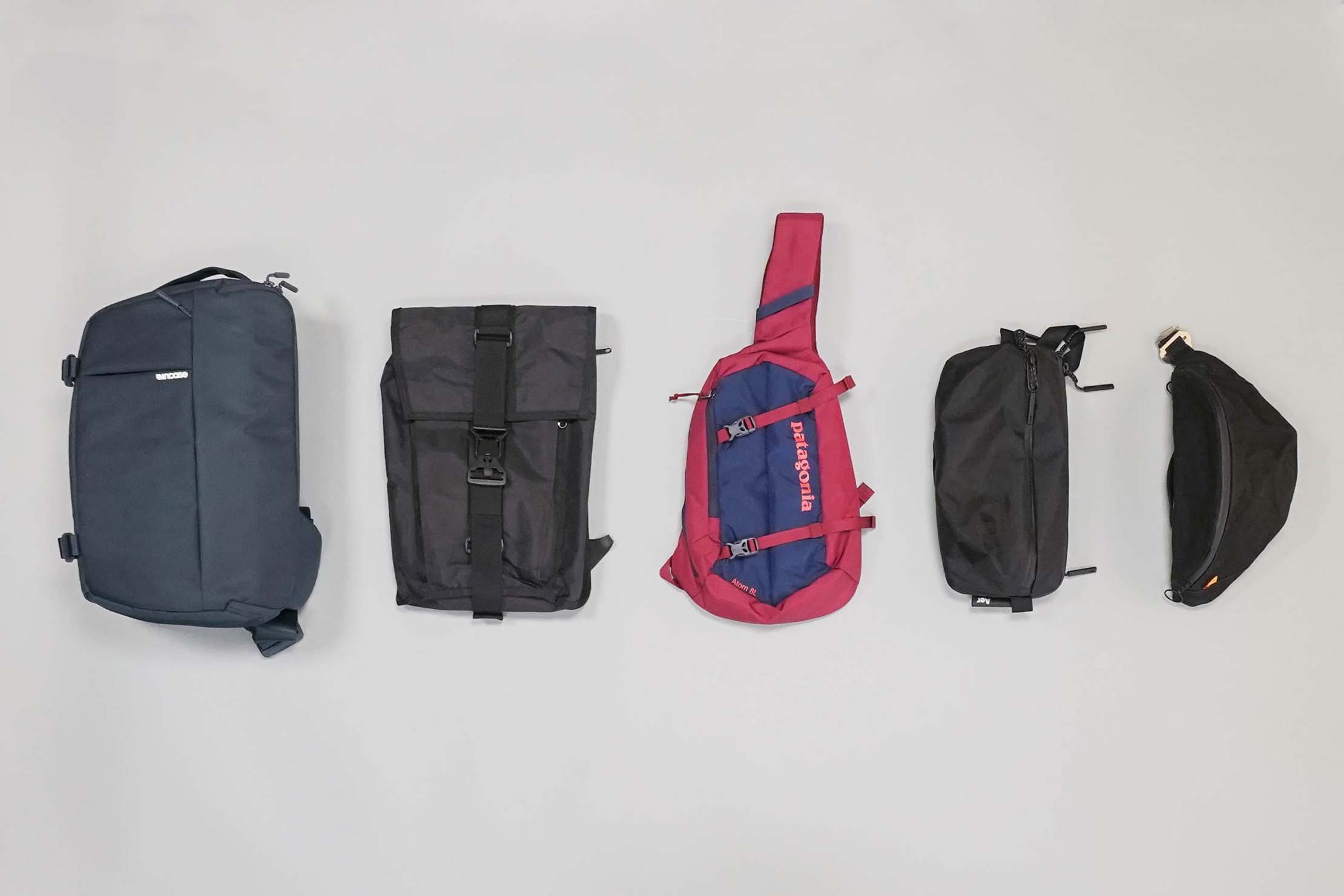
While a sling’s size is measured in liters, the liter size of a sling bag can vary from company to company. One brand’s 5 liters is another brand’s 2 liters (exasperating, right? Get it together, people!). So it’s equally important to consider the shape of the sling bag, the internal organization, and the thickness of the material—all of which will impact the amount of usable space available. Let’s break that down.
Volume & Size
We know we just said judging a sling bag by liters isn’t the most accurate way to determine volume, but it still works well as a benchmark. We recommend staying between one and eight liters and keeping the weight less than four, maybe five, pounds—this weight includes your stuff, of course. Since a sling bag wears over one shoulder, a big, heavy sling may, at best, get too uncomfortable to carry, and at worst, hurt your back. Plus, it’ll look awfully strange sitting across the chest.
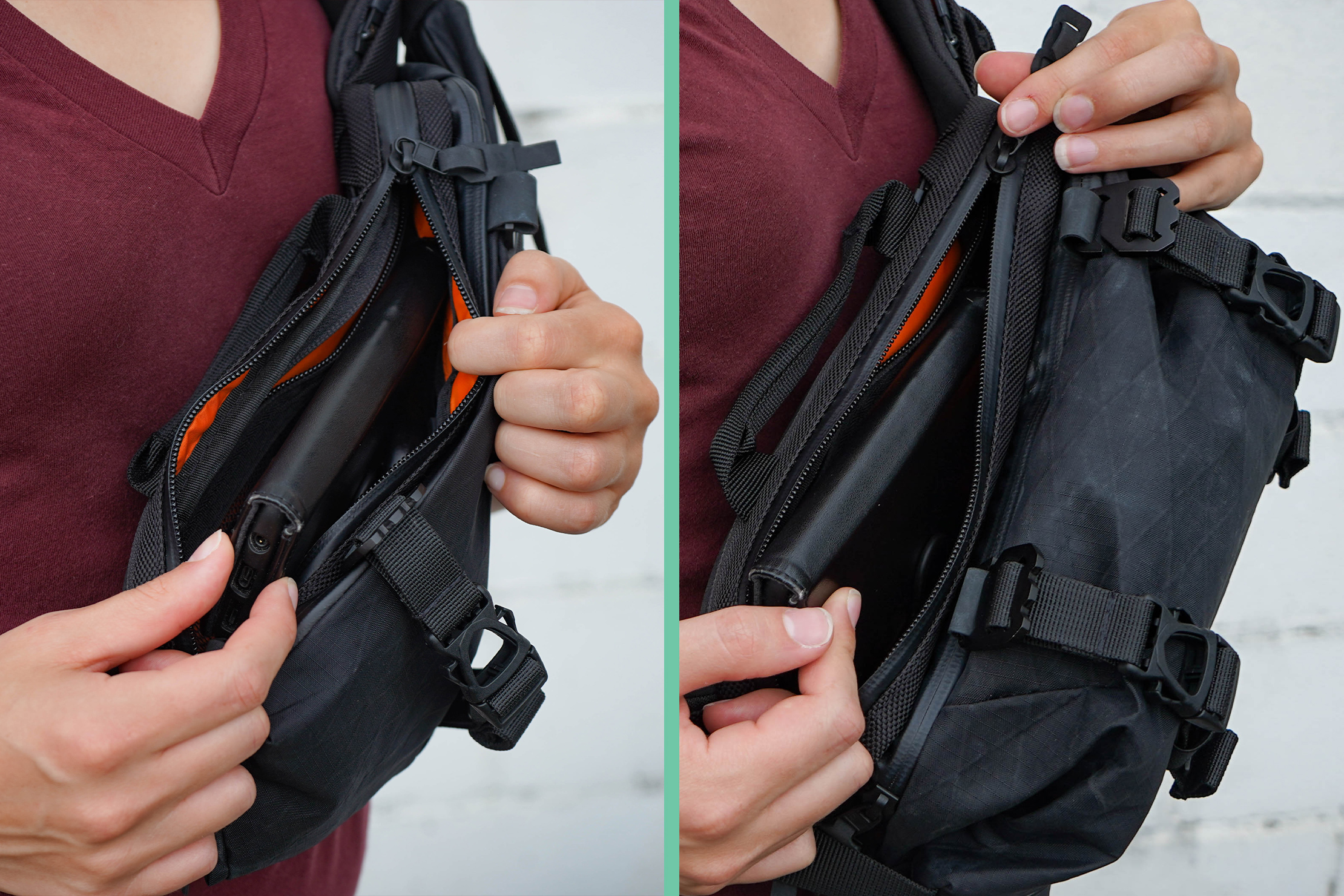
Some sling bags are expandable, which is excellent for travel since they’ll take up little space when not in use or when you don’t have much to carry—but you can still fill them with a decent amount of stuff when expanded. This trick works well on small sling bags but can be overkill on bigger ones, which expand to be comically bulky.
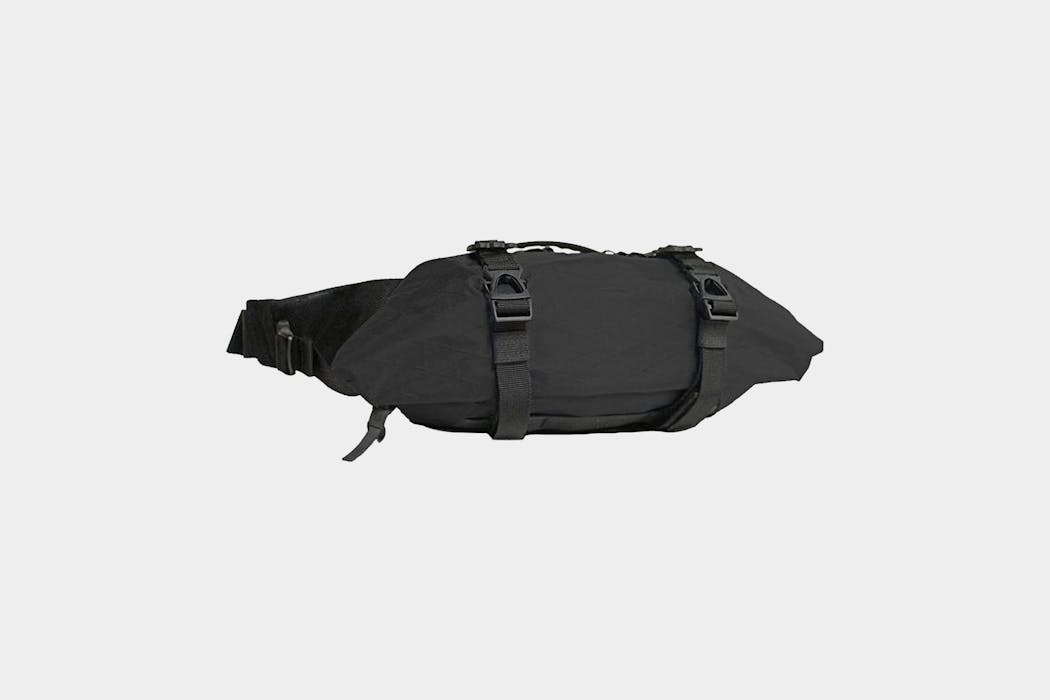
CODEOFBELL X-POD
With an expandable main compartment, the CODEOFBELL X-Pod works equally well on days when you only need the essentials and on trips where you want everything but the kitchen sink. Plus, it never looks too bulky and manages to stay comfortable even when fully packed—an impressive feat we don’t often see.
Profile
The profile of a sling bag has a significant impact on its overall look and comfort level. Most sling bags have an oblong shape to better fit the chest and back. As we mentioned earlier, sometimes hip packs try to be sling bags—some are even successful at it—but they won’t be nearly as contoured to the chest and can hang in such a way as to look unbalanced.
With sling bags, you’ll usually find one of two orientations: tall or wide. They’re both equally great options that work better or worse for different use-cases and style preferences.
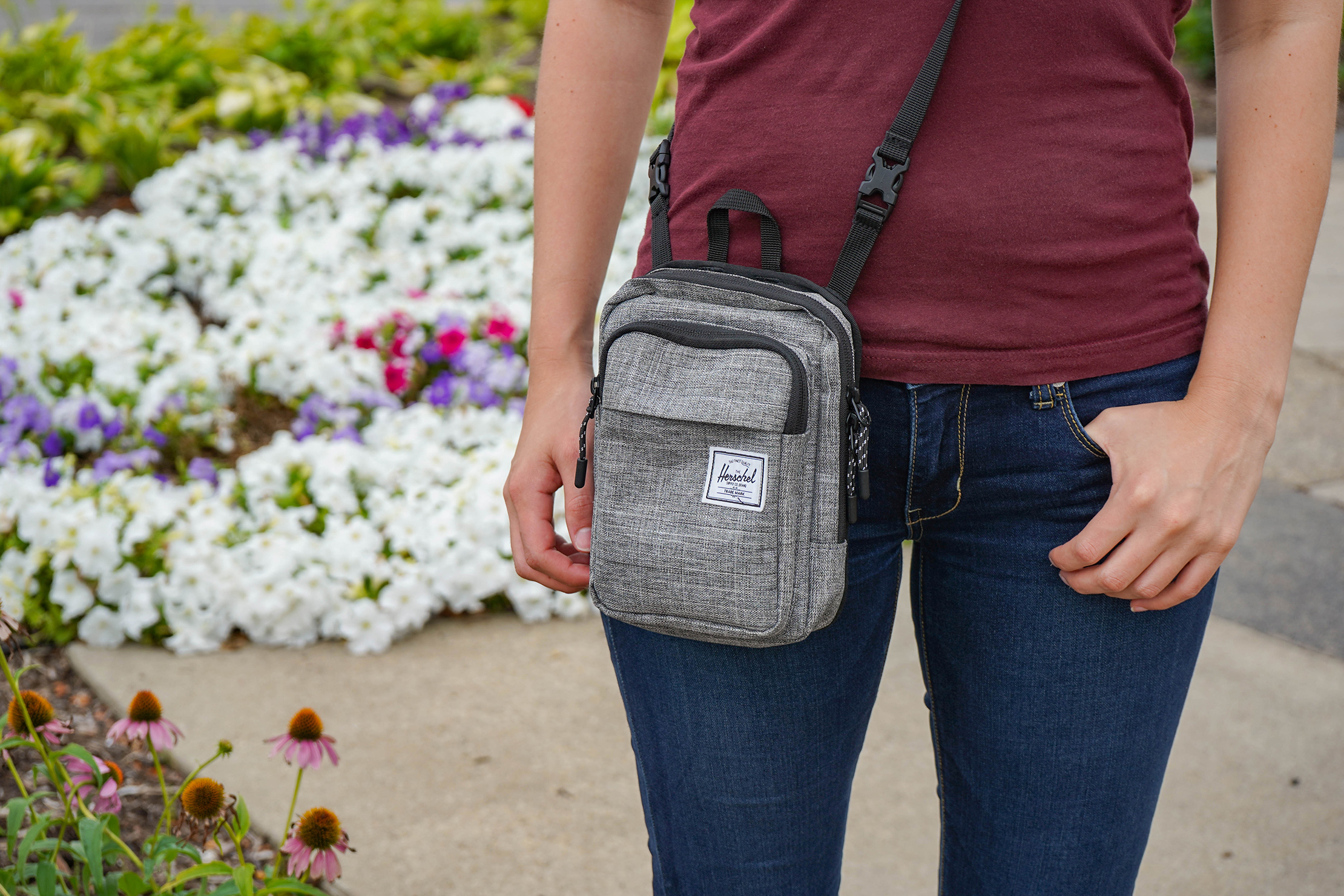
Tall sling bags are just that—tall—and wear more like a purse or mini-backpack. As you would expect, they work well for things that you want to pack vertically, say a phone case with bunny ears. Tall sling bags aren’t usually tight against the body, nor can they only be worn on your back.

Herschel Supply Co. Form Crossbody Large
This sling bag looks like a miniature backpack—or a regular-sized backpack for teddy bears—which we can certainly get behind. And it has great organization. Its three main compartments are outfitted for a variety of items, ensuring that you’ll never lose anything to the dreaded crossbody-bag-blackhole again. We only wish you could wear it closer to the chest.
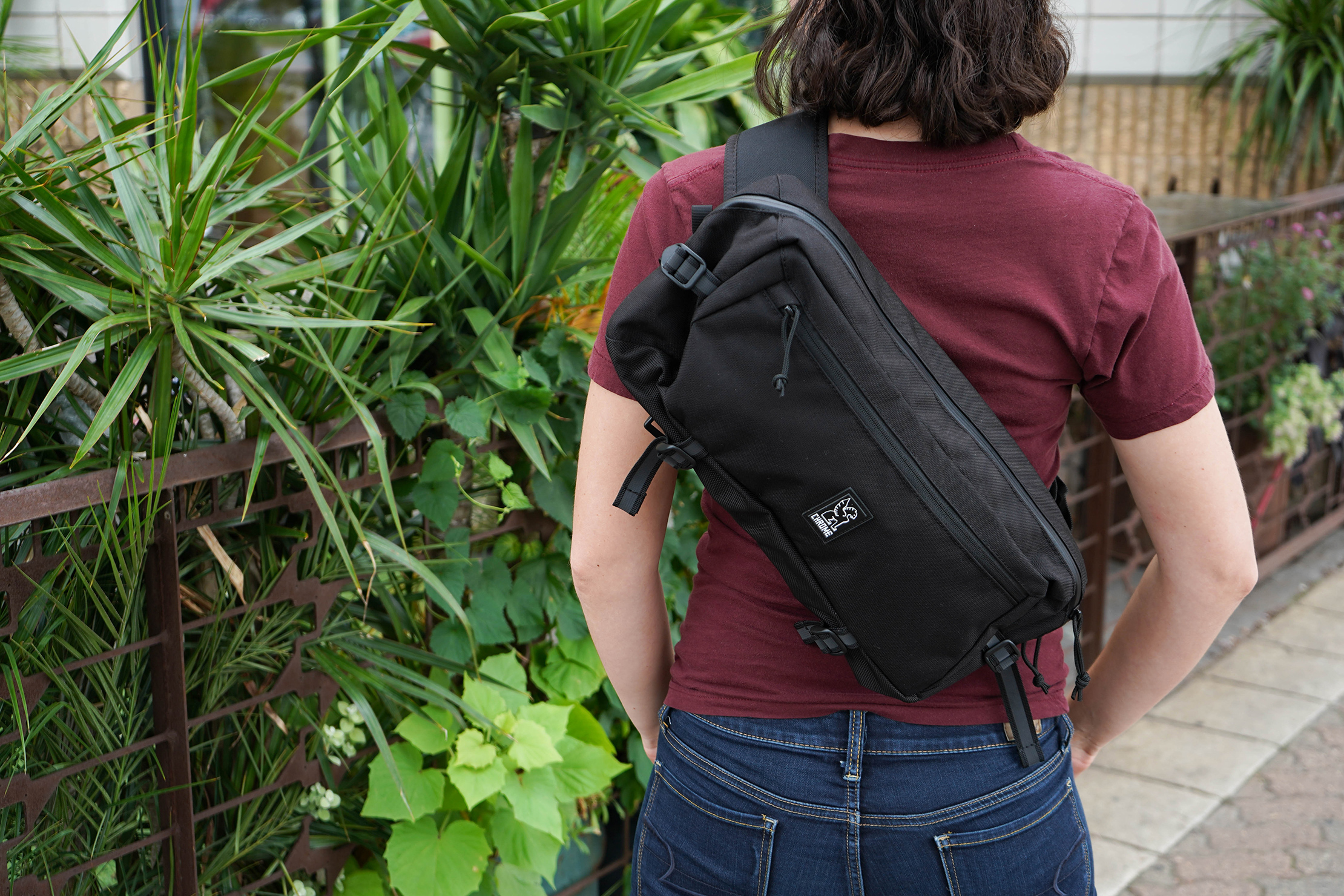
If you want to look like you don’t know how to wear a fanny pack correctly, then a wide sling may be your style of choice. That’s to say, they are more closely related to the fanny pack in the looks department, for better or worse, and usually sit tightly against the body.

Chrome Industries Kadet
Chrome Industries prides itself on its unique, recognizable designs. And this sling bag is definitely unique. Its oblong shape is reminiscent of the typical fanny pack, but its larger size, seat belt buckle, and stiff shape are all its own. It can overwhelm smaller frames—particularly when full—but it’ll hold all of the essentials and then some.
Weather Resistance
You’ll likely carry important gear in your sling bag such as your cell phone, money, and passport. Unless you’ve got special powers that allow you to avoid rain and snow indefinitely, a bit of weather resistance is a major plus, as it will protect those essential items from damage. Plus, a weather-resistant sling can be wiped down quickly, meaning you won’t have to wear a sopping wet bag against your chest—not a fun experience.
On the other hand, too much weatherproofing is overkill. Full-blown waterproof or super weather-resistant materials are built for just that—resisting water. Generally speaking, they’re not going to hold up to everyday use as well as other fabrics (more on that below), and they may not look as nice or feel as comfortable on your back/chest.
If push comes to shove and you need to protect your sling from a sudden rainstorm, they’re usually small enough to fit under a rain jacket. Just beware—people may think you are either smuggling a small animal under your coat or have a bizarrely shaped chest. (This could be a pro or con depending on your personality.)
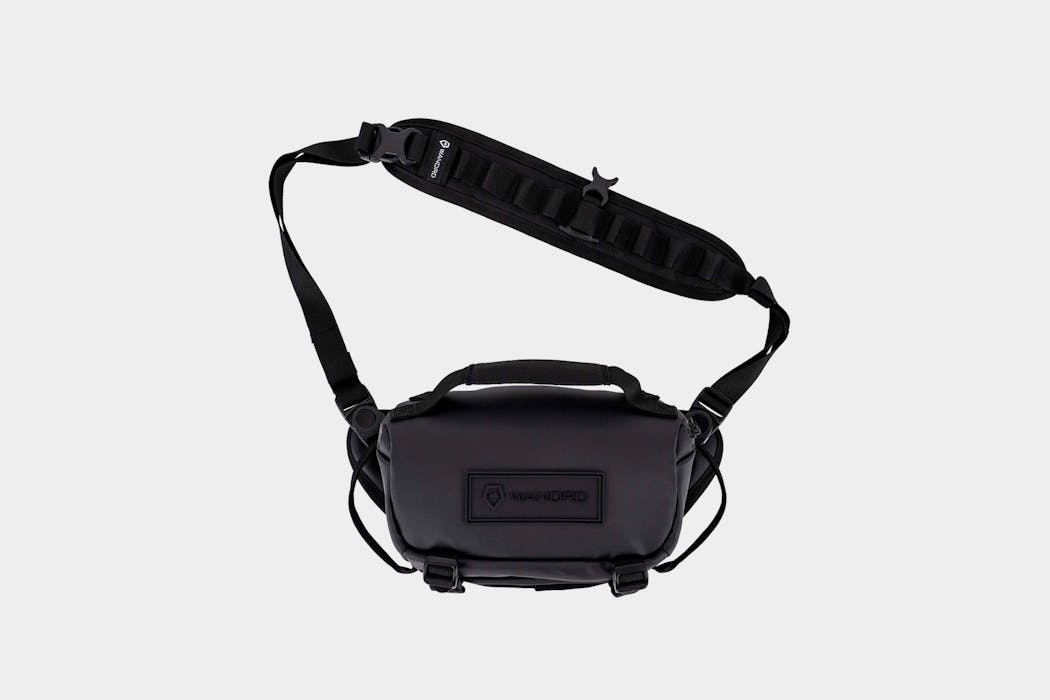
WANDRD ROAM Sling
A sling bag designed to carry your essential tech—small laptops included—better have some weather resistance. And the WANDRD ROAM Sling doesn’t disappoint, with high-quality, weather-resistant fabric and zippers.
Sling Bag Durability & Quality
With the popularity of sling bags on an exponential rise, you’ll find sling bags ranging from ten bucks to thousands. While we don’t recommend going out and buying a sling bag that costs as much as a car (unless you have money to burn), we do recommend purchasing a sling made of durable, high-quality materials—and that may cost you more than ten bucks.
That said, the same fabric that’s ideal for a travel backpack can be a bit much on a sling bag. You have to balance durability with weight and interior capacity. When you’re looking at quality, be sure to pay attention to:
Zippers
A broken zipper may lead to a broken heart while traveling. That may sound dramatic, but if you’ve ever had a zipper break on you while abroad, you’ll know exactly what we mean. We usually trust zippers from YKK, RiRi, and SAB—all of which have solid track records for making quality products, our favorite being the Japanese manufacturer, YKK. YKK zippers have rarely let us down, even when we’ve put them through the wringer over years and years of testing. They account for about half of all the zippers in the world for a reason.

Beyond the brand, it’s important to consider size, which is measured on a scale of one (small) to ten (large). While the main zippers on sling bags fall all over this spectrum, the most common sizes are #5 or #8—seriously, out of the 50 + slings we’ve tested, a very, very high majority have either #5 or #8 zippers. Anything less than a five and you’ll likely run into durability issues.
With sling bags, you also don’t need—or want—anything too beefy, like a #10 zipper. If they’re too big, the zips can jingle, which gets annoying for us around the five-minute mark. Maybe you’re more patient than we are. Larger zippers can also rub against your chest or back, which is just as uncomfortable as it sounds.
Some companies purposefully design their sling bags with oversized zippers or zipper teeth to look extra dope. If you’re into this aesthetic, you may have to get used to the jingling. Fashion is pain and all that.

For the zippers on internal or less-frequented pockets, you’ll be okay with a smaller size. They can also help with the aforementioned weather resistance. When looking at zippers, you may see the letters RC stamped next to the size (#5RC, #8RC, etc.). RC stands for reverse coil, a term that describes zippers with internally—rather than externally—facing teeth, which helps prevent water from percolating into the bag. But a reverse coil zipper isn’t that water-resistant. So don’t go thinking it’ll protect your phone in a monsoon.
For further protection, there are water-repellent zippers—like the YKK Aquaguard zipper—which have a thin polyurethane coating to, you know, repel water. If you’re planning on going to an unusually wet area with your sling bag, then you may want to look for this style of zipper. Otherwise, you’ll likely be fine without that extra water resistance.
Hardware
Buckles are a major component of most sling bags, and if there’s no buckle, there will be some sort of clip. You don’t want the hardware to break on you because that’ll make the sling practically useless. Unless you MacGyver up a big knot, which will help with the usefulness but, let’s be real, look totally ridiculous.
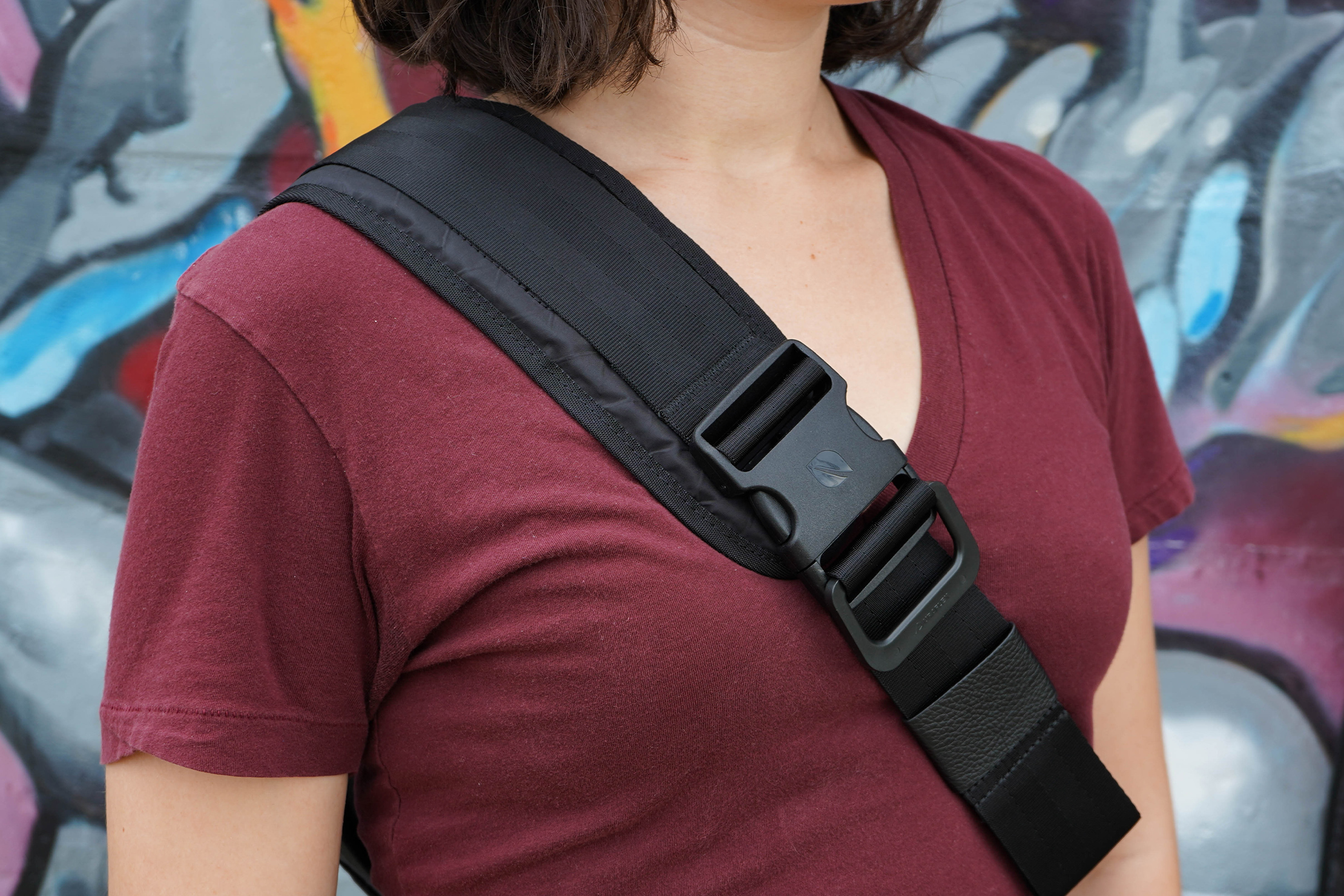
Again, the brand matters here. Some trustworthy companies are Duraflex, YKK, Woojin, and ITW. As long as you stick with them, you should be good to go. We also love metal buckles—as opposed to plastic—but when it comes to slings, they can be uncomfortable and add a good bit of weight. If durability is a priority however, metal buckles can’t be beaten.
Fabric & Material
Unlike in the 1800s—or even the mid-1900s—bag designers (engineers?) have a ton of fabrics to choose from to make their bags, all of which have pros and cons. As we’ve already mentioned, you want to balance durability with weight and capacity. A sling bag won’t have to do as much work as a travel backpack; therefore, it doesn’t have to be as tough. Some materials you may run into are:
Nylon

You’re probably familiar with nylon since it’s a common synthetic fabric that manages to be soft, durable, and lightweight (go science!). These qualities make it suitable for a variety of products, and slings are no exception. That said, it’s is more of a blank canvas these days and is often infused with weaves, sewing patterns, or extra fibers that make the fabric more durable, tear, or weather-resistant.
Ballistic Nylon

Initially developed for military body armor, ballistic nylon is strong…and possibly a bit overkill on a sling bag. While we love that you won’t have to worry about the exterior of your bag falling apart on you, it does weigh more than other fabrics and feels stiff against the body. Still, it’s a great choice thanks to its exceptional resistance to pilling and water. Plus, it won’t do any damage to your clothing as it rubs against it.
Ripstop Nylon

The magic of ripstop nylon is all in its name. Due to its magical properties—AKA, the extra fibers that are sewn into its square weave—ripstop nylon prevents punctures from spreading into full-on rips. Moreover, like plain old nylon, ripstop has a high strength-to-weight ratio, meaning it’s lightweight but still remarkably strong—a significant asset for a sling bag. Plus, it’s currently used in ejector seat parachutes for fighter pilots(!), and if it’s good enough for fighter pilots, it’s good enough for us.
Polyester

Polyester is another standard synthetic fabric, but clocks in at a lower price than nylon. It’s generally heavier, too. If you’re looking to buy a cheap sling bag to hold some beer at music festivals and you don’t care that it won’t last more than one season, polyester will suit you well. We should point out that there are some reasonably-durable polyester sling bags out there, but those are usually blended with other fabrics (especially in the lining and/or other sensitive areas).
CORDURA® Grade Fabrics (Nylon & Polyester)

CORDURA® is a brand, not a fabric, but it’s still worth mentioning since you’ll likely run into it more than a few times. CORDURA® nylon and polyester is the exact same as traditional nylon and polyester, the only difference being that the fabric has come from a CORDURA®-approved mill and production line. The CORDURA® label is basically a stamp of quality assurance—it’s pretty much a guarantee that anything CORDURA® will have excellent abrasion resistance and an impressive strength-to-weight ratio.
Canvas

You aren’t going to see a lot of canvas sling bags out there, but the few that do exist have an antiquated and sophisticated air about them. That’s because canvas—particularly cotton canvas—was the fabric that started it all. Canvas is heavier and more susceptible to abrasions than synthetics, but unlike synthetics, its weatherproofing is usually obtained by wax, which can be re-proofed, ensuring continual water-resistance and durability.
Leather

Remember when we just said that canvas is the fabric that started it all? Well, technically speaking, that isn’t entirely accurate because leather has been around a lot longer. But in today’s day and age, you aren’t going to see a ton of leather sling bags—especially in a travel context (they’re more common on runways). Leather isn’t great for travel since it’s heavy, sensitive to the elements, and requires a decent amount of maintenance. We suggest sticking with a leather wallet and finding a sling bag made of basically anything else.
While this isn’t a comprehensive list of all of the fabrics you’ll run into while shopping (sorry sailcloth and polypropylene) a majority of sling bags will be made with one or multiple of the materials mentioned above. But the material itself isn’t the be-all, end-all.
Usually, you’ll see a number followed by a D associated with the material—250D, 950D, 1000D, etc. The D stands for denier, which is the unit that measures the weight or thickness of fabric. In general, the higher the number, the more durable the fabric—but higher numbers also mean higher weight.
Because every fabric has its individual strengths (nylon is inherently stronger than polyester) the denier won’t help you much when comparing two different types of fabrics, or even two types of weaves within one fabric family. Instead, it helps you compare two fabrics of the same type. 500D Ballistic nylon is less durable than 1000D Ballistic nylon, for example. But the 500D Ballistic nylon will also be much lighter (about half as light, in fact!).
When it comes to sling bags, higher denier is generally better, but you start maxing out around 500D. As far as we’re concerned, any fabric over 500D is a bit overkill for a sling bag. As you get up into the 500D range, the weight of the fabric will start to become more substantial, but because sling bags are small—and thus don’t have a lot of fabric—you’ll hardly be able to notice this difference in weight. And because sling bags don’t take as much abuse as, say, a full-blown travel backpack, we don’t think the extra durability of 500D+ fabrics is necessary.
Moreover, the other aspects of a sling bag, including its zippers and hardware, also have to be high-quality. It does you no good if your ballistic nylon exterior has held up if your zippers break on week three. Best to keep everything well-rounded.

Aer City Sling 2
Bordering on too durable, the Aer City Sling 2 is made of some tough stuff—1680D CORDURA® Ballistic nylon, to be precise. If you’re looking for a sling bag that will keep up while you roam the world, this one should be on your radar.